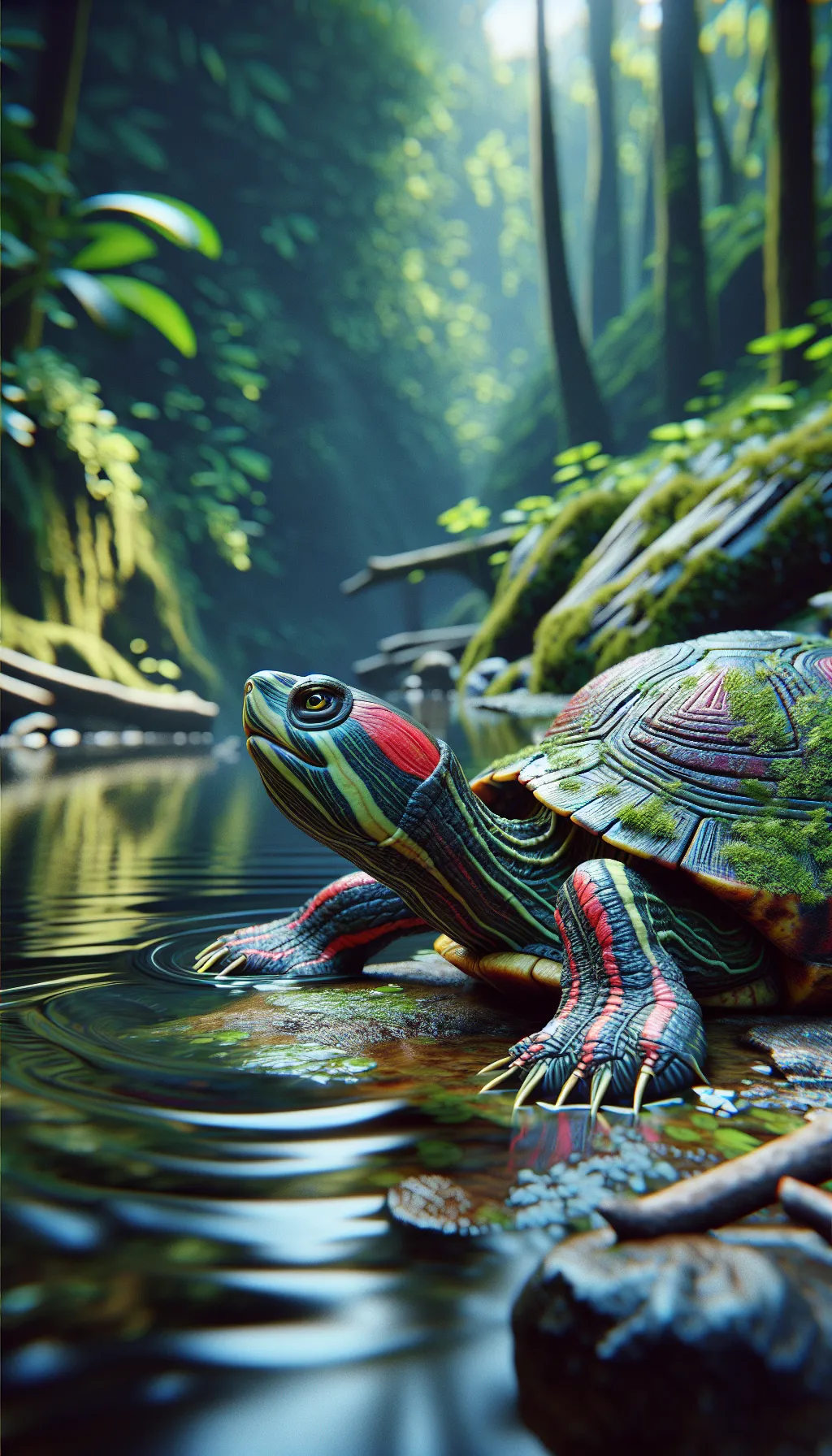The Red-Eared Slider
The Red-Eared Slider is a semi-aquatic turtle known for its distinctive red markings on the sides of its head. They have a smooth, oval-shaped shell that can range in color from olive green to brown. These turtles have webbed feet and are excellent swimmers, spending most of their time in the water. Red-Eared Sliders are popular as pets and are commonly found in lakes, ponds, and rivers in North America.

| Red-Eared Slider | |
|---|---|
| Size | Up to 8 inches (20 cm) |
| Weight | 2-3 pounds (0.9-1.4 kg) |
| Speed | 20 mph (32 km/h) |
| Key Strength | Sharp claws for defense |
| Biggest Weakness | Slow movement on land |
| Scientific Name | Trachemys scripta elegans |
| Family | Emydidae |
| Habitat | Freshwater bodies like ponds, lakes, and rivers |
| Geography | Originally from the central United States, now found worldwide as pets |
| Diet | Omnivorous - plants, insects, small fish |
| Lifespan | 20 years - 40 years |

The Red-Eared Slider
The Red-Eared Slider is a semi-aquatic turtle known for its distinctive red markings on the sides of its head. They have a smooth, oval-shaped shell that can range in color from olive green to brown. These turtles have webbed feet and are excellent swimmers, spending most of their time in the water. Red-Eared Sliders are popular as pets and are commonly found in lakes, ponds, and rivers in North America.
Fun Fact: Red-Eared Sliders are able to bask in the sun for hours to regulate their body temperatures because they are cold-blooded animals.
| Red-Eared Slider | |
|---|---|
| Size | Up to 8 inches (20 cm) |
| Weight | 2-3 pounds (0.9-1.4 kg) |
| Speed | 20 mph (32 km/h) |
| Key Strength | Sharp claws for defense |
| Biggest Weakness | Slow movement on land |
| Scientific Name | Trachemys scripta elegans |
| Family | Emydidae |
| Habitat | Freshwater bodies like ponds, lakes, and rivers |
| Geography | Originally from the central United States, now found worldwide as pets |
| Diet | Omnivorous - plants, insects, small fish |
| Lifespan | 20 years - 40 years |
Red-Eared Slider Matchups
We use AI to simulate matchups between the Red-Eared Slider and other animals. Our simulation considers size, strength, and natural predatory behaviors to determine the most likely outcome.
Red-Eared Slider: Diet, Predators, Aggression, and Defensive Behaviors
What do Red-Eared Sliders eat?
Red-Eared Sliders are omnivores, meaning they eat a variety of foods. Their diet typically consists of aquatic plants, insects, small fish, and even some fruits and vegetables. They are known to be opportunistic feeders and will eat almost anything that they can fit in their mouths.
Do Red-Eared Sliders have any predators?
Yes, Red-Eared Sliders have predators in the wild. Some of their main predators include raccoons, birds of prey, large fish, and snakes. When they are young, they are particularly vulnerable to predation because of their small size and lack of protection.
Are Red-Eared Sliders aggressive?
Red-Eared Sliders are not typically aggressive towards humans, but they can exhibit territorial behavior towards other turtles or animals. Males especially may become aggressive towards each other during mating season. It is important to provide them with enough space and hiding spots to reduce potential aggression.
Do Red-Eared Sliders fight?
Red-Eared Sliders may engage in aggressive behaviors, especially during territorial disputes or mating season. Males can become quite aggressive towards each other, often fighting for dominance or access to mates. These fights can result in injuries such as bite marks or shell damage.
How do Red-Eared Sliders defend themselves?
Red-Eared Sliders have a few mechanisms for self-defense. When they feel threatened, they may retreat into their shells to protect themselves. They can also use their claws and beak to defend against predators or competitors, as well as their ability to swim quickly to escape danger.
What is the biggest weakness of Red-Eared Sliders in a fight?
One of the biggest weaknesses of Red-Eared Sliders in a fight is their relatively small size and lack of physical strength compared to larger predators or aggressive individuals of their species. Their shell provides some protection, but it is not impenetrable, leaving them vulnerable to attacks from larger, more aggressive animals.
Fun Fact: The name "Red-Eared Slider" comes from the striking red stripe near their eyes, which resembles an ear, hence the name "Red-Eared."
Fun Fact: Red-Eared Sliders are omnivores and have a varied diet, which includes aquatic plants, insects, fish, and even small amphibians.










